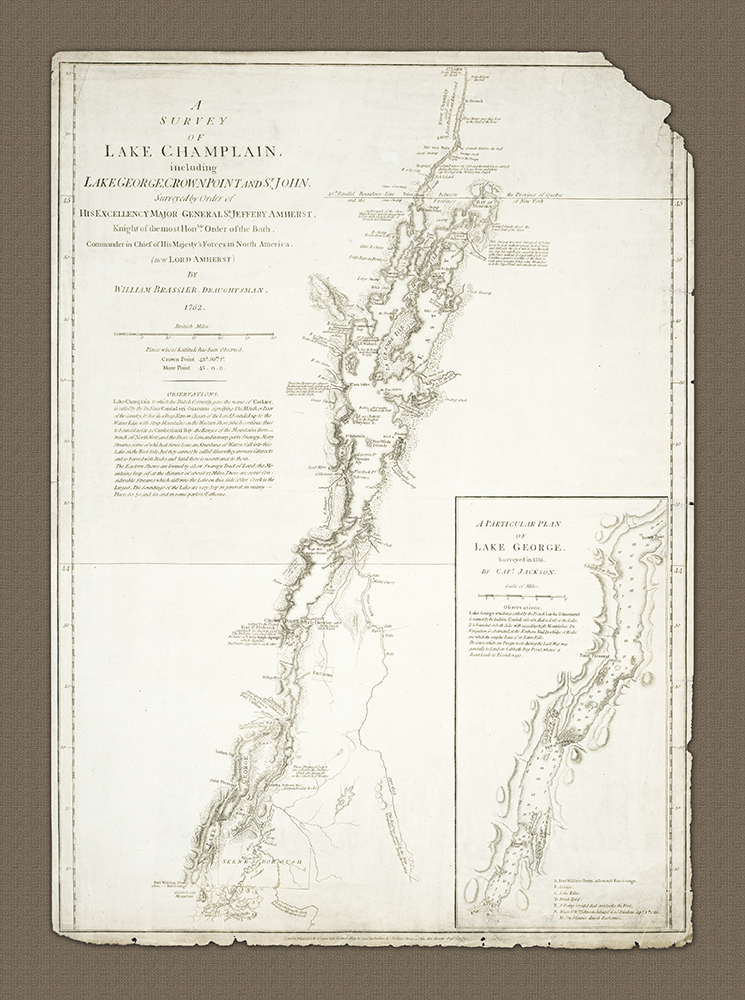
A214b - Lake Champlain & Lake George (uncolored)
An uncoloured version of Sayer and Bennet's 1776 map of Lake Champlain and Lake St. George. The main part of the map is that of Lake Champlain, based on a survey by William Brassier, taken in 1762 during the French Indian War.
- 1776
William Brassier & Captain Jackson, pub Sayer & Bennett
- h30.5" x w22.5"
- P
The survey for the inset map of Lake George was completed by Captain Jackson, earlier, in 1756. Both surveys had remained in manuscript form until the onset of the Revolutionary war in 1775, when London publishers Sayer and Bennett, in response to a demand of maps of the region engraved and published both surveys in this form.
It was first issued in Jeffrey's American Atlas of 1776. This copy is beautifully colored and highlights the 45 parallel boundary line between Ontario and New York. Later in 1776 a second state of the map was published in Sayer and Bennett's American Military Pocket Atlas - the so-called Holster Atlas. That second, and far more common, state of the map differs from this in as much as it shows the engagement of the British and American Fleets off the Isle of Valcour on October 11, 1776, their movements down the river, and a second engagement off Crown Point on October 13, 1776, with lettered references.
Notes relating to observations, events and structures appear on lake Champlain and keys are provided on the Lake George inset. The overall (strategic) significance of Lake Champlain is, to a great extent based on it's geographic location: Dense forests made overland travel in areas such as this and both native Indians and Europeans made as much us of waterways as possible.
The 'Champlain corridor' which runs north from New York up to the St. Lawrence River and Montreal was inevitably seen as a vital overland short-cut between the Hudson River at Albany with its connection down to New York and the St. Lawrence River with its connection to Montreal.
Along with several smaller rivers and lakes, Lake Champlain, the longest and largest of these waterways, provided a link between the two major rivers (and cities). This route had been used for decades by fur traders, Indians, missionaries and soldiers, who travel using canoes and bateaus.
Historically the French had controlled the territory at northern end of the lake and the Americans Lake St. George to the south. In 1755, the governor of Canada ordered the construction of Fort Carillon (Ticonderoga) at the place where travellers had to move overland between Lake Champlain and Lake George. Sir William Johnson responded by erecting Fort William Henry (later Fort George) at the southern tip of Lake George.
There had been several engagements in the region during the French Indian war, at Ticonderoga and Crown Point (Fort Frederic) in particular. In 1776, the Richelieu/Champlain/Lake George corridor very quickly became the basis for British strategic planning after the outbreak of rebellion in the New England colonies in 1775, with the intention being to control the route totally and thus cut-off the rebellious New England states from the rest of the colonies.
Although the British in the North had far superior forces in the region they knew from their experience in the French Indian war that unless they had naval supremacy and control of the water they could not advance further south safely.
The only significant craft on the waters in July 1776 were American. Brigadier General John Sullivan had written to George Washington in June of 1776 to say 'I know of no better method than to secure the important posts of Ticonderoga and Crown Point, and by building a number of armed vessels to command the lakes, otherwise the forces now in Canada will be brought down upon us as quick as possible, having nothing to oppose them'. He, prophetically, went on to say that 'They will doubtless try to construct some armed vessels and then endeavour to penetrate the country toward New York.'
By the end of the Summer of 1776, after a frantic race to build ships by the British at the north end of the lake and the Americans at the south, a significant engagement was fought by the two navies at Valcour Island on the 11th October.
Although the battle was a tactical victory for the British it proved to be a strategic success from the American standpoint. The British had been delayed from securing the lakes, just before the on-set of winter and the American forts Ticonderoga and William-Henry (later George) were spared.
The later American victory at Saratoga to the south the following year proved to be the undoing of the British plan. Ethan Allen, Benedict Arnold and the Green Mountain Boys successfully took the fort at Ticonderoga from the British in May 1775 and the cannons were removed to support the American siege of Boston. The following day the Americans also took the British fort at Crown point, on the other side of the lake.
Ticonderoga was later reclaimed by the British under command of General John Burgoyne in June 1777 as the British swept south and held until the British defeat at Saratoga in September and eventual surrender of Burgoyne's army in October.
- Lake Champlain & Lake George (uncolored)


